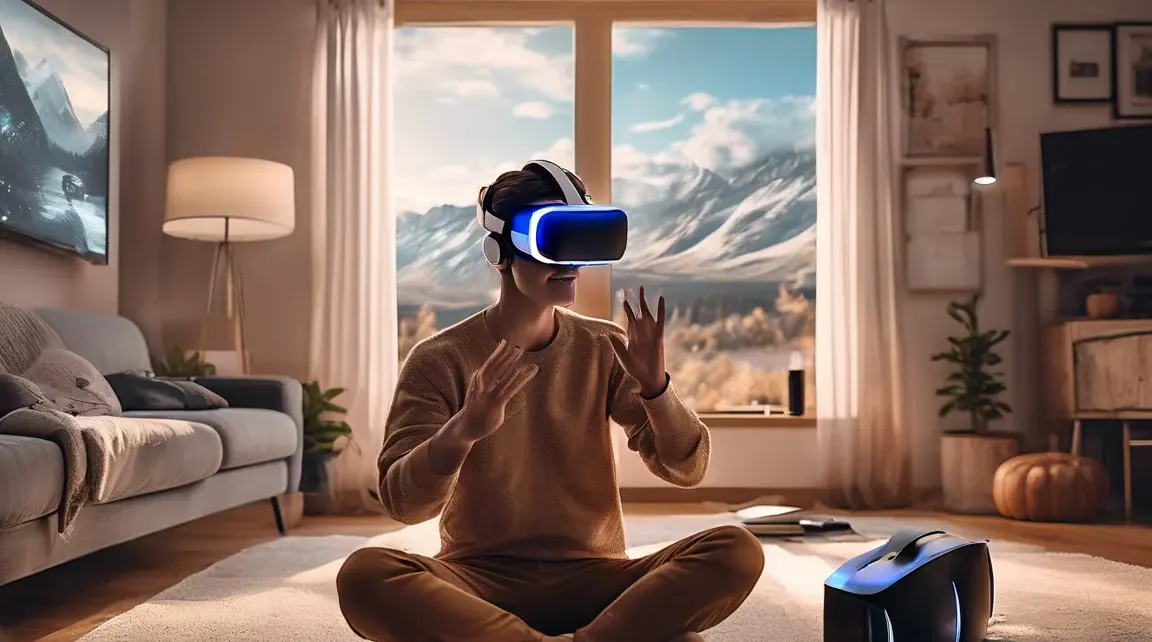Virtual reality (VR) might sound like something out of a science fiction movie—but it’s no longer a futuristic dream. Today, VR is a fast-growing, accessible technology that allows users to fully immerse themselves in interactive digital environments. Whether you’re gaming, learning, socializing, or exploring faraway worlds from your living room, VR offers something incredible for everyone.
In this guide, we’ll explore what virtual reality is, how it evolved, how to choose the right gear, set up your space, and maximize your experience with expert tips and tricks. Whether you’re a total beginner or just looking to level up your setup, this post has you covered.
What Is Virtual Reality? Understanding VR and Its Related Technologies
At its core, virtual reality is a technology that places you inside a 3D digital environment where you can interact with the world around you. By wearing a VR headset, you’re not just watching a screen—you’re stepping inside the scene. Whether it’s exploring alien planets or practicing your golf swing, VR makes it feel real.
The Evolution of Virtual Reality
VR has come a long way since the 1990s, when clunky headsets and limited graphics defined the experience. Thanks to rapid advancements in computing power, motion tracking, and display quality, today’s headsets are lighter, more comfortable, and far more affordable. Devices like the Meta Quest, HTC Vive, and PlayStation VR2 are helping VR reach mainstream adoption.
What About AR and MR?
Augmented Reality (AR): Overlays digital elements (like filters or game characters) onto the real world using your smartphone or AR glasses.
Mixed Reality (MR): Combines both real and virtual environments in a more interactive way. Think of MR as a bridge between VR and AR.
Knowing the difference helps you choose the right tech for your interests—whether it’s immersive gaming, virtual meetings, or hybrid real-world interactions.
Why Try Virtual Reality? Benefits Beyond Just Gaming
While VR gaming is a huge draw, it’s far from the only use case. Here’s why so many people are diving into the world of VR:
Immersive Learning and Education: Visit historical landmarks, dissect a virtual frog, or explore the solar system in stunning detail.
Professional Training: Surgeons, pilots, and even military personnel use VR for realistic, risk-free training scenarios.
Social VR Experiences: Attend live concerts, visit museums, or hang out in virtual cafes with friends from around the globe.
Fitness and Wellbeing: Play VR boxing, rhythm games, or yoga apps to stay active and fit—without hitting the gym.
Preparing Your Space: How to Set Up the Ideal VR Environment
Before diving into your new VR headset, it’s important to create a safe and comfortable play area. Here’s how to get started:
1. Clear the Floor Space
Most room-scale VR setups require a minimum play area—typically about 6.5 feet by 6.5 feet (2m x 2m). Move furniture and fragile items out of the way so you can move freely and avoid accidents.
2. Optimize Lighting
Good lighting helps your headset’s sensors track motion accurately. Avoid direct sunlight or overly bright rooms. Soft, even lighting works best.
3. Safety First
Use a mat or area rug to create a physical boundary. This provides tactile feedback and helps you stay centered. Also, check for overhead obstacles like hanging lights or low ceilings if you’re playing standing-up games.
4. Sound Matters
A quality audio setup—whether through built-in speakers or high-end headphones—can transform your VR experience. Directional and immersive audio help make digital environments feel lifelike.
Choosing the Right VR Gear: Headsets, Controllers, and More
Ready to jump into VR but not sure where to start? Here’s a breakdown of essential gear to help you make the best decision:
1. Selecting a VR Headset
Popular VR headset options include:
Meta Quest 2 / 3: All-in-one, wireless, great for beginners.
HTC Vive Series: High-end performance with PC connectivity.
PlayStation VR2: Ideal for console gamers seeking immersive experiences.
When choosing, consider factors like resolution, refresh rate, field of view, comfort, and whether the headset is standalone or PC-tethered.
2. Controllers vs. Hand Tracking
Some VR systems come with motion controllers, while others use hand-tracking technology. Controllers offer more precise input for complex games, while hand tracking feels natural for casual and social apps.
3. PC or Console Compatibility
If you’re not using a standalone headset like the Quest, your PC or console specs matter. A powerful GPU, enough RAM, and USB/HDMI ports are essential for smooth VR performance.
4. Budget Considerations
You don’t have to break the bank to get into VR. Starter bundles are available for under $300, while high-end rigs can go upwards of $1,000. Consider your goals (gaming, fitness, design) and expand as needed.
How to Set Up Your VR System: A Step-by-Step Installation Guide
Step 1: Unbox Your Equipment
Lay out everything included with your VR kit. This usually includes the headset, controllers, cables, and possibly base stations or tracking sensors.
Step 2: Assemble and Connect
Follow the user manual to connect your headset and controllers to your PC or console. For plug-and-play devices like Meta Quest, this step is minimal.
Step 3: Position Tracking Sensors
If your VR system uses external sensors (like HTC Vive), place them in opposite corners of your play space, angled downward. Make sure they’re secure and have power.
Step 4: Install Software and Drivers
Most headsets will prompt you to install companion software (e.g., SteamVR, Meta Quest app). Follow on-screen setup instructions and calibrate your space as directed.
Step 5: Troubleshoot if Needed
If something goes wrong, double-check all connections, restart your system, and refer to the official support page for your device. Online forums like Reddit and Discord VR groups can also be helpful.
Maximizing Your VR Experience: Pro Tips for Beginners
Once your setup is ready, here’s how to get the most out of every VR session:
Learn the Controls
Spend time in tutorials or beginner games to learn how movement and interaction work. Mastering VR controls can significantly improve immersion and enjoyment.
Explore a Variety of Apps
VR isn’t just for first-person shooters. Try:
Educational Apps – like Google Earth VR or Mission: ISS
Fitness Games – such as Beat Saber, Supernatural, or FitXR
Social Platforms – including VRChat, Rec Room, and Horizon Worlds
Maintain Your Gear
Keep lenses clean using microfiber cloths. Wipe down your headset and controllers after use, especially after intense workouts. Store your gear safely to avoid damage.
Take Regular Breaks
Too much time in VR can lead to motion sickness or eye strain. Follow the 20-20-20 rule: every 20 minutes, take a 20-second break and look at something 20 feet away.
Final Thoughts: Why Now Is the Perfect Time to Get Into VR
Virtual reality is no longer just a trend—it’s shaping the future of digital interaction. Whether you’re seeking thrilling adventures, new ways to learn, or immersive social spaces, VR offers unmatched possibilities.
With more affordable gear, expanding content libraries, and better hardware, now is the best time to start your VR journey. Use this guide to prepare your space, choose the right equipment, and unlock the full potential of immersive experiences.


